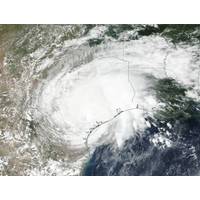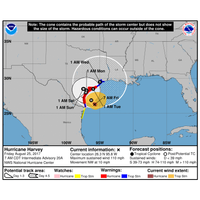Helene reaches hurricane strength in Gulf of Mexico and threatens Florida
The National Hurricane Center reported that the powerful storm Helene became a hurricane Wednesday morning. It was packing winds of up to 130 kph (80 mph) as it churned off the coast of Yucatan Peninsula in the eastern Gulf of Mexico. Forecasters said that Helene would continue to intensify throughout Thursday and bring a life-threatening storm to Florida's coast. The National Weather Service warned that more than 40 millions people in Florida and Georgia, as well as Alabama, were under tropical storm and hurricane warnings on Wednesday.
Cuba and Florida prepare for Tropical Storm Helene's impact
The U.S. National Weather Service reported that Tropical Storm Helene will cause mudslides, flooding and major hurricane-like conditions in Cuba. It is then expected to reach major hurricane status on Thursday when it reaches Florida with a life-threatening ocean tide. The National Hurricane Center in Miami said that Helene was moving northwest at a speed of 45 mph with sustained winds up to 72 kph. Forecasters say Helene is expected to strengthen rapidly over the warm waters of Gulf of Mexico, resulting in a major hurricane with winds up to 115 mph.
Alberto Moves Inland, Flash Floods Threaten Alabama
Subtropical storm Alberto fizzled into a subtropical depression as it rolled into Alabama on Tuesday but forecasters warned of potentially dangerous flash floods even as winds dropped to 30 miles per hour (48 km per hour). At its height, Alberto, the first storm of the 2018 Atlantic hurricane season, blasted sustained winds of 65 mph (105 kph) with gusts that packed full hurricane punches of 75 mph (121 kph), said meteorologist David Roth of the National Weather Service. "It's slowly weakening and it's not regaining any strength," Roth said.
Subtropical Storm Alberto's Landfall Expected Early Next Week
U.S. Gulf of Mexico producers and refiners are monitoring Subtropical storm Alberto, which is expected to make landfall between east Louisiana and the Florida panhandle early next week, the companies said on Friday. The National Weather Service on Friday predicted the storm would bring heavy rain to the central Gulf Coast region and the southeastern United States later this weekend and continue into early next week. The Louisiana Offshore Oil Port (LOOP)…
Irma forces Bahamas Borco Terminal to Close
Buckeye Partners LP's Bahamas terminal, also known as Borco, has been closed for vessel traffic and will shut all operations by the end of the day due to Hurricane Irma, a source familiar with operations said on Thursday. That terminal, located in Freeport, on Grand Bahama Island, has more than 26 million barrels of storage capacity for crude, fuel oil, gasoline and other products. Hurricane Irma has already killed several people after hammering the Caribbean as a category 5 storm, with winds up to 180 mph (285 km/h).
Harvey Drenches Louisiana, Sparks Blast at Texas Chemical Plant
The remnants of Tropical Storm Harvey drenched northern Louisiana on Thursday as it moved inland, leaving behind record flooding that paralyzed the U.S. energy hub of Houston, killed at least 35 people and drove tens of thousands from their homes. Two explosions were reported at a flood-hit chemical plant in Crosby, Texas, 30 miles (48 km) northeast of Houston, with one sheriff's deputy sent to the hospital after inhaling toxic chemicals. The Arkema SA plant had lost power as a result of the storm…
Harvey's Rains Shut in More Refineries, Sending Fuel Prices Higher
U.S. fuel prices surged on Monday as two more Gulf Coast refiners cut output and a third considered reductions, leaving more than 13 percent of the country's refining capacity offline after Tropical Storm Harvey flooded plants and shut seaports. The storm swung back over the Gulf of Mexico on Monday and was expected to bring another 10 to 15 inches (25 to 38 cm) of rain to the Houston area and up to 8 inches as far east as New Orleans, the National Weather Service said.
Harvey Throws a Wrench into US Energy Engine

A hurricane in the heart of the U.S. energy industry is expected to upend years of U.S. excess oil capacity and low prices, with the impact expected to reverberate globally and affect energy markets for weeks. Harvey hit the Texas shore as a fierce Category 4 hurricane, causing massive flooding that knocked out 11.2 percent of U.S. refining capacity, a quarter of oil production from the U.S. Gulf of Mexico, and closed ports all along the Texas coast.
Residents Flee South Texas Ahead of Harvey
Residents fleeing most powerful storm on U.S. mainland since 2005. Businesses closed and lines of cars streamed out of coastal Texas as officials called for residents to evacuate ahead of Hurricane Harvey, expected to arrive about midnight as the most powerful storm to hit the U.S. mainland in more than a decade. The hurricane is forecast to slam first near Corpus Christi, Texas, drop flooding rains along the central Texas coast and potentially loop back over the Gulf of Mexico before hitting Houston, some models showed.
Hurricane Harvey Strengthens, Threatens US

Hurricane Harvey intensified early on Friday into potentially the most powerful hurricane to hit the U.S. mainland in more than a decade, as authorities warned locals to shelter from what could be life-threatening winds and floods. Harvey is set to make landfall late Friday or early Saturday on the central Texas coast where Corpus Christi and Houston are home to some of the biggest U.S. refineries. Oil and gas operations have already been disrupted and gasoline prices have spiked. "Now is the time to urgently hide from the wind.
Colder 2016-17 Winter to Boost U.S. oil and gas Demand
The U.S. summer driving season ends with Labor Day on Sep 5, and the attention of the energy markets is already switching to the forthcoming winter heating season. The winter of 2015/16 was the warmest on record, which sharply reduced consumption of both natural gas and heating oil (http://tmsnrt.rs/2bhIGoL). Average winter temperatures are very variable, but the winter of 2016/17 will almost certainly be colder, which should lead to a significant increase in gas and heating oil demand.
La Nina to Boost U.S. Heating Oil Demand: Kemp
Middle distillates remain the one ray of hope for U.S. oil refiners still struggling to clear a glut of gasoline caused by over-production earlier in the year. Stocks of distillate fuel oil are higher than normal but have been trending down for the last 15 weeks according to the U.S. Energy Information Administration. Distillate stocks are currently around 152 million barrels, almost 8 million barrels higher than at the same point last year and more than 20 million barrels over the 10-year median.
La Nina may boost U.S. Heating Oil Demand
Middle distillates remain the one ray of hope for U.S. oil refiners still struggling to clear a glut of gasoline caused by over-production earlier in the year. Stocks of distillate fuel oil are higher than normal but have been trending down for the last 15 weeks according to the U.S. Distillate stocks are currently around 152 million barrels, almost 8 million barrels higher than at the same point last year and more than 20 million barrels over the 10-year median.
February Snow Could Reduce U.S. Fuel Inventories
The blizzard that battered the U.S. East Coast over the weekend may be just a taste of what is to come, as February is usually the snowiest month and is likely to be snowier this year because of the El Nino weather phenomenon, weather experts say. The historic storm paralyzed much of the heavily populated East Coast and snowy gridlock closed government and businesses in Washington for 2-1/2 days. More snow heading into February, beginning with flurries expected in some parts of the northeast on Thursday and Friday…
U.S. Refiners brace for Glitches in Winter Cold
U.S. refineries along the East Coast and the Midwest are facing their first major test of the winter season since last year's blistering cold set off a string of outages, sending gasoline and diesel prices soaring. Freezing temperatures have descended upon the U.S. Northeast and Midwest ahead of a potentially historic storm that threatens to dump as much as 24 inches (61 cm) of snow in parts of the I-95 highway corridor running between Boston and Washington this weekend, according to the National Weather Service.
Illinois Battles Flooding as Mississippi River Builds Downstream
Residents of flooded areas in far southern Illinois anxiously waited for the swollen Mississippi River to peak on Sunday, with hundreds electing to remain in their homes, as states downstream prepared for the rising waters. About 125 structures were flooded in hard-hit Alexander County, the southernmost point in Illinois, where three families near one breach stayed dry behind sandbag fortifications and private levees, county board Chairman Chalen Tatum said.
West Texas Snow Impacts Crude Output
A snowstorm dumped around two feet (60 cm) of snow in parts of the Permian Basin in West Texas and New Mexico over the weekend, crimping some crude output and leaving roads dangerous for trucks heading to and from oil wells, forecasters and companies said on Monday. Snow had stopped accumulating by Monday afternoon but "travel continues to be impacted as most roads are slick and snow-covered," and some roads across southeastern New Mexico were still closed, according to a notice from the National Weather Service's Midland, Texas, office.
Hurricane Patricia Brings Rain, Flooding to Louisiana
Torrential rainstorms battered Louisiana on Sunday, leaving thousands without power, after pounding southeastern Texas as the remnants of Hurricane Patricia converged with a second storm. The heaviest band of rain moved over the Gulf of Mexico, triggering coastal flood warnings and flash flood watches in southwest Louisiana and soaking New Orleans, according to the National Weather Service (NWS). About 22,000 people were left without power in the greater New Orleans area.
Burning All Fossil Fuels could Thaw Antarctica, Raise Seas-Study
Burning all the world's fossil fuel reserves could thaw the entire Antarctic ice sheet and push up world sea levels by more than 50 metres (160 feet), over thousands of years, an international study said on Friday. Such a melt, also eliminating the far smaller ice sheet on Greenland, is a worst case of climate change that would inundate cities from New York to Shanghai and change maps of the world with much of the Netherlands, Bangladesh or Florida under water.
El Nino More Likely to Last Into N. Hemisphere Spring
A U.S. government weather forecaster on Thursday raised the likelihood that El Nino conditions would last into the Northern Hemisphere's early spring to 85 percent, up from 80 percent in the prior month's forecast. The Climate Prediction Center, an agency of the National Weather Service, also maintained its forecast that the chances of El Nino conditions lasting through the Northern Hemisphere winter were more than 90 percent. El Nino, the warming of Pacific sea-surface temperatures…
